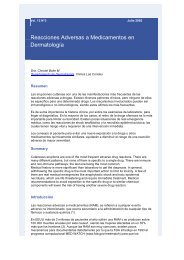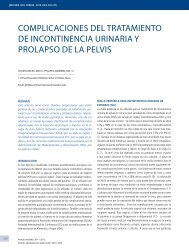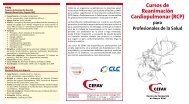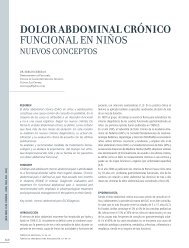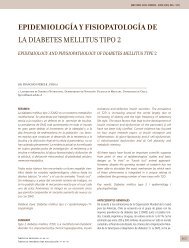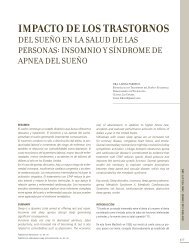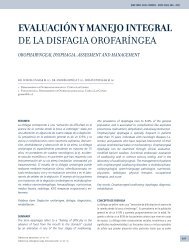[REV. MED. CLIN. CONDES - <strong>2013</strong>; <strong>24</strong>(1) 15-20]more vulnerable to radiation than adults. This is in part due to the factthat there is a longer life expectancy in which to manifest potentialradiation induced cancers, which can be life-long. In addition, the careof children can be more complicated than adults. For those healthcareproviders who are not familiar with the different spectrum of pediatricillness and manifestations of injury, there may be a lower thresholdto request imaging evaluation. For imaging experts, lack of familiaritywith the often special imaging techniques to maximize quality andminimize radiation may result in studies with excessive radiation dosesto children. For all care providers, there is often increased anxietyespecially when caring for severely ill or injured children that mayalso affect the choice (e.g. lower thresholds for requesting) of imagingstrategies (7). For these reasons, the following material present asummary information on radiation risks for children from diagnosticmedical imaging.ADDITIONAL RESOURCES IN THE LITERATUREThe following list is provided at this point to let those that areinterested know that there are excellent resources for additionalinformation to the ensuing discussion. For the following generalsections, the reader is referred to select references (note that therewill be some overlap of this material and this division into categoriesis somewhat arbitrary): radiation biology: Hall and Brenner (8);justification for medical imaging: Hendee, et al (9); general reviewof CT and radiation: Hricak, et al (10); radiation doses of diagnosticmedical imaging examination in adults: Mettler, et al (11); radiationdoses of studies in children: Fahey, et al (12); current review ofcancer risks from diagnostic imaging procedures in adults, children,and in experimental animal studies: Linet (13); controversies in riskestimations for medical imaging: Hendee, O’Connor (14); strategieson dose reduction for medical imaging using ionizing radiation inchildren: Frush (15), Nievelstein (16); education material (includingmaterial specific for parents and non-imaging healthcare providers):Image Gently website (www.imagegently.org) in children andfor adults, Image Wisely (www.imagewisely.org); evidence-basedassessment of risk and benefit in medical imaging in children usingionizing radiation: Frush, Applegate (17).RADIATION BIOLOGYThe biological effects of radiation are derived principally from damageto DNA. The x-ray particle, a photon, releases energy when interactingwith an electron. The electron may act either directly on DNA (directaction or affect) but may also interact on a water molecule resultingin a free radical, which in turn can damage DNA (indirect action oraffect). The indirect effect is the more dominant effect, consistingof approximately 2/3 of photon interactions. DNA damage resultsin either single stranded breaks or double stranded breaks. Singlestranded breaks are usually well repaired with minimum bioeffects.Breaks in both strands of DNA (which are in close proximity) are moreproblematic to repair and underlie disruptive function that can result incell death or in impaired cellular function resulting in the developmentof cancer. These inappropriate repairs with resultant stable aberrationscan initiate one of the multi-step processes in radiation inducedcarcinogenesis. Of note, there are some chemicals, which serve asradioprotectants, primarily in the setting of radiation oncology thathave recently been reviewed (18). While not yet applicable to generaldiagnostic imaging, these DNA stabilizing agents provide a model forradiation protection at the cellular level.Radiation results in two biological effects: deterministic and stochasticeffects. For virtually all diagnostic imaging (CT, nuclear medicine,and radiography and fluoroscopy) radiation doses are at the levelswhich are stochastic. Stochastic effects are generally disruptionsthat result in either cancer or heritable abnormalities. For diagnosticimaging, the discussion is limited almost exclusively to the potentialfor cancer induction; heritable effects (i.e., on gametes) have notbeen shown to occur in diagnostic levels of radiation in humans. Fora stochastic effect, the risk increases with the dose but the severityof the effect (i.e., the severity of cancer) does not increase. There isalso no threshold for this risk (see following discussion on modelsof radiation risks based on dose). The other biological effect isdeterministic. Deterministic effects include cataracts, dermatitis (skinburns), and epilation (hair loss). With the deterministic effect, theamount of radiation determines the severity of effect. For example,the greater amount of radiation, the more extensive the hair loss. Withdeterministic effects, there is a threshold. Below this threshold theinjury does not occur. Deterministic effects can be seen with extensiveinterventional procedures, and certainly with doses delivered fromradiation oncology. Deterministic effects are, except for very unusualcircumstances, including imaging errors, not encountered in duringdiagnostic medical imaging examinations.RADIATION DOSEA brief review of radiation units will be helpful for the subsequentmaterial. First, radiation can be measured as exposure; however thisis not useful in determining risks since it says nothing about whatthe organs at risk actually receive. Individual patient risk for organspecific cancer can be determined if the absorption of the radiation,the absorbed dose, measured in Gray (Gy), is known. Obviously, thiscannot be determined during routine medical imaging for an individualpatient but there are estimations for organ doses. The biologicalimpact on the tissue may vary depending on the type of radiationdelivered. For diagnostic imaging, this is the x-ray, and the waitingfactor ends up being 1.0 so that the equivalent dose (in Sieverts, Sv)is equal to the absorbed dose in Gy (in medical imaging the measureis milli Gy, or mGy since this is the scale of doses encountered). Thefinal unit of import is the effective dose (in Sv, or mSv in the range ofdiagnostic imaging) which is commonly used metric in discussions ofdiagnostic imaging radiation dose. It is formally determined by the sumof the exposed organs and their equivalent doses (in mSv) multipliedby weighting factors which depend on the differing radiosensitive of16
[Radiation Risks to Children from Medical Imaging - Donald P. Frush, MD, FACR, FAAP]those organs that are exposed. The effective dose is a very generaldose unit. It could be similar to say an average rainfall for a countryper year. This average rainfall takes into account regional and seasonalvariations into a single number, but there is no way to extract from theaverage rainfall the specific data on the coastal rainfall in summermonths. Effective dose (derived from experiments and models of organdoses since, again we cannot practically measure internal organ dosesduring medical imaging) represents an equivalent whole body dose(like the yearly average rainfall) from what may be regional exposures.For example, a brain CT may result in an effective dose of 2.0 mSv.A pelvic CT may result in an effective dose of 4.0 mSv. This meansthat the pelvic CT equivalent for the whole body exposure is twicethat of a brain CT. However, it is easy to see that any potential risksfrom the brain CT to the lens of the eye for example are going to begreater than the pelvic CT. While the effective dose continues to bethe most commonly used metric in discussing ionizing radiation dosefrom imaging modalities in the clinical realm, it is still problematic andoften misunderstood measure (19-21).The doses for imaging modalities can vary widely, more than a factor ofa hundred. In general, radiography of the extremities such as the ankle,wrist, or elbow provide very low doses, and computed tomography andnuclear imaging studies tend to provide relatively higher doses. Again,these are effective doses, or whole body equivalents that, allow thevarious imaging modalities to be compared with respect to an overallpopulation risk but not an individual patient risk. Doses will dependon the various technical factors used for various imaging studies. Inparticular, fluoroscopy and angiography doses may vary dependingon the indication for the evaluation, or various findings during theprocedure. An upper gastrointestinal series with a small bowel followthrough will in general have a higher fluoroscopic dose than a simplefluoroscopic cystogram in children. Doses for nuclear medicine studiescan be quite low or relatively high (11, 12). Single imaging doses inchildren from a single CT examination may be as low as less than 1.0mSv to 10-20 mSv (11, 13, 22).IMAGING UTILIZATIONS: PATTERNS OF USEOverall, there are nearly 4 billion diagnostic imaging evaluations thatuse ionizing radiation performed worldwide (23). Given the currentworld population, this means more than one examination for everyindividual in the world is performed every other year. Obviously, noteveryone has an examination and various populations of patientswill have significant number of examinations per year. If one looks atmedical imaging use in the United States, it has substantially increasedover the past 30 years (<strong>24</strong>). Previously, about 3.5 mSv was the annualtotal radiation per capita dose, 85% coming from backgroundradiation (for example, radon, cosmic radiation, naturally occurringradioisotopes). Before 1980, an effective dose of approximately 0.53mSv (about 15% of the total) was estimated to result from medicalimaging. This is now 3.0 mSv (23), a nearly 600% increase. Currently,in the United States, 48% of all radiation to the population is frommedical imaging. Nearly half of this is from CT and the vast majorityof medical radiation is due to combination of CT and nuclear imaging.In fact, CT in the United States now accounts for nearly 25% of theper capita radiation exposure per year. This is largely due to increasein medical imaging, rather than higher doses per procedure. Thereasons for this increased use are complex but, as noted before, CThas provided an increasingly valuable tool in a number of settings,including evaluation of trauma, especially brain injury, in the settingof cardiovascular disease, including thromboembolism, and othercardiovascular abnormalities (such as acquired and congenital heartdisease in children), and in the clinical setting of acute abdominalpain, such as appendicitis.Currently, in the United States, nearly 80 million CT examinations areperformed per year (25) which equates to about one CT evaluationperformed per year for every four individuals. In the U.S., the use ofmedical imaging is also frequent in children. For example, Dorfman etal noted that out that over a three year period in a U.S. populationconsisting of more than 350,000 children from a group of health carenetworks, nearly 43% underwent at least one diagnostic imagingprocedure using ionizing radiation, and nearly 8% had at least oneCT examination (26). Larson noted a five-fold increase in the numberof CT examinations from 330,000 to over 1.65 million from 1995 to2008 (27).While these data do indicate that the use of medical imaging inchildren has increased substantially over the past few decades, someother data indicate that at least the use of CT imaging in children hasdeclined over the past few years (28, 29), and further investigationswill need to determine if this is a sustained trend.RISK ESTIMATIONS FOR CANCER FROM IONIZING RADIATIONIN MEDICAL IMAGING:In general, risk estimations for medical imaging in both adults andchildren come from four sources consisting of studies of populationsexposed to atomic bombs (the Radiologic Effects Research Foundation-RERF), occupational exposures, medical exposures, and environmentalexposures, such as the Chernobyl accident. An excellent review of theRERF data is found in article by Linet (13). The various reports fromthese sources have comprised the most cited source for determiningrisks, the Biological Effects of Ionizing Radiation (BEIR) Committeefrom the National Academy of Sciences. The most recent report is BEIRVII. While BEIR VII report is the foundation for many risk estimatesincluding medical imaging, there are some problems with the report.As noted by Hendee et al, “... many articles that use the BEIR VIIreport to forecast cancer incidence and deaths from medical studiesfail to acknowledge the limitations of the BEIR VII and accept its risksestimates as scientific fact rather than as a consensus opinion of acommittee” (14). Rather than a detail discussion of the limitations ofthe BEIR VII Report, it is probably more worthwhile to just understandthat estimations of cancer risks, such as the levels provided by medicalimaging, continue to be speculative. We also estimate the dose17
- Page 3 and 4: [ÍNDICE]ÍNDICERevista Médica Cl
- Page 7: [Algunos hitos históricos en el de
- Page 13 and 14: [Algunos hitos históricos en el de
- Page 15: [REV. MED. CLIN. CONDES - 2013; 24(
- Page 20 and 21: [REV. MED. CLIN. CONDES - 2013; 24(
- Page 22: [REV. MED. CLIN. CONDES - 2013; 24(
- Page 25 and 26: [RIESGOS DE LA RADIACIÓN IMAGINOL
- Page 27: [REV. MED. CLIN. CONDES - 2013; 24(
- Page 33 and 34: [Neumonías adquiridas en la comuni
- Page 35: [Neumonías adquiridas en la comuni
- Page 38 and 39: [REV. MED. CLIN. CONDES - 2013; 24(
- Page 40 and 41: [REV. MED. CLIN. CONDES - 2013; 24(
- Page 42 and 43: [REV. MED. CLIN. CONDES - 2013; 24(
- Page 44 and 45: [REV. MED. CLIN. CONDES - 2013; 24(
- Page 46 and 47: [REV. MED. CLIN. CONDES - 2013; 24(
- Page 48 and 49: [REV. MED. CLIN. CONDES - 2013; 24(
- Page 51 and 52: [IMAGINOLOGÍA ACTUAL DEL CÁNCER P
- Page 53 and 54: [IMAGINOLOGÍA ACTUAL DEL CÁNCER P
- Page 55 and 56: [EVALUACIÓN CARDIACA CON TOMOGRAF
- Page 57 and 58: [EVALUACIÓN CARDIACA CON TOMOGRAF
- Page 59: [EVALUACIÓN CARDIACA CON TOMOGRAF
- Page 62 and 63: [REV. MED. CLIN. CONDES - 2013; 24(
- Page 64 and 65: [REV. MED. CLIN. CONDES - 2013; 24(
- Page 66 and 67:
[REV. MED. CLIN. CONDES - 2013; 24(
- Page 68 and 69:
[REV. MED. CLIN. CONDES - 2013; 24(
- Page 70:
[REV. MED. CLIN. CONDES - 2012; 201
- Page 74 and 75:
[REV. MED. CLIN. CONDES - 2013; 24(
- Page 76 and 77:
[REV. MED. CLIN. CONDES - 2013; 24(
- Page 78 and 79:
[REV. MED. CLIN. CONDES - 2013; 24(
- Page 80 and 81:
[REV. MED. CLIN. CONDES - 2013; 24(
- Page 82 and 83:
[REV. MED. CLIN. CONDES - 2013; 24(
- Page 84 and 85:
[REV. MED. CLIN. CONDES - 2013; 24(
- Page 86 and 87:
[REV. MED. CLIN. CONDES - 2013; 24(
- Page 88 and 89:
[REV. MED. CLIN. CONDES - 2013; 24(
- Page 90 and 91:
[REV. MED. CLIN. CONDES - 2013; 24(
- Page 92 and 93:
[REV. MED. CLIN. CONDES - 2013; 24(
- Page 94 and 95:
[REV. MED. CLIN. CONDES - 2013; 24(
- Page 96 and 97:
[REV. MED. CLIN. CONDES - 2013; 24(
- Page 98 and 99:
Sistema de ultrasonido PHILIPS iU22
- Page 100 and 101:
[REV. MED. CLIN. CONDES - 2013; 24(
- Page 102 and 103:
[REV. MED. CLIN. CONDES - 2013; 24(
- Page 104 and 105:
[REV. MED. CLIN. CONDES - 2013; 24(
- Page 106 and 107:
[REV. MED. CLIN. CONDES - 2013; 24(
- Page 108 and 109:
108
- Page 110 and 111:
[REV. MED. CLIN. CONDES - 2013; 24(
- Page 112 and 113:
[REV. MED. CLIN. CONDES - 2013; 24(
- Page 114 and 115:
[REV. MED. CLIN. CONDES - 2013; 24(
- Page 116 and 117:
[REV. MED. CLIN. CONDES - 2013; 24(
- Page 118 and 119:
[REV. MED. CLIN. CONDES - 2013; 24(
- Page 120 and 121:
[REV. MED. CLIN. CONDES - 2013; 24(
- Page 122 and 123:
[REV. MED. CLIN. CONDES - 2013; 24(
- Page 124 and 125:
[REV. MED. CLIN. CONDES - 2013; 24(
- Page 126 and 127:
[REV. MED. CLIN. CONDES - 2013; 24(
- Page 128 and 129:
[REV. MED. CLIN. CONDES - 2013; 24(
- Page 130 and 131:
[REV. MED. CLIN. CONDES - 2013; 24(
- Page 132 and 133:
[REV. MED. CLIN. CONDES - 2013; 24(
- Page 134 and 135:
[REV. MED. CLIN. CONDES - 2013; 24(
- Page 136 and 137:
[REV. MED. CLIN. CONDES - 2013; 24(
- Page 138 and 139:
[REV. MED. CLIN. CONDES - 2013; 24(
- Page 140 and 141:
[REV. MED. CLIN. CONDES - 2013; 24(
- Page 142 and 143:
[REV. MED. CLIN. CONDES - 2013; 24(
- Page 145 and 146:
[PRINCIPIOS FÍSICOS E INDICACIONES
- Page 147:
[PRINCIPIOS FÍSICOS E INDICACIONES
- Page 150 and 151:
[REV. MED. CLIN. CONDES - 2013; 24(
- Page 152 and 153:
[REV. MED. CLIN. CONDES - 2013; 24(
- Page 154 and 155:
[REV. MED. CLIN. CONDES - 2013; 24(
- Page 156 and 157:
[REV. MED. CLIN. CONDES - 2013; 24(
- Page 158 and 159:
[REV. MED. CLIN. CONDES - 2013; 24(
- Page 160 and 161:
[REV. MED. CLIN. CONDES - 2013; 24(
- Page 162 and 163:
[REV. MED. CLIN. CONDES - 2013; 24(
- Page 164 and 165:
[REV. MED. CLIN. CONDES - 2013; 24(
- Page 167 and 168:
[Medicina Nuclear e Imágenes Molec
- Page 169 and 170:
[REV. MED. CLIN. CONDES - 2013; 24(
- Page 171:
[DENSITOMETRÍA ÓSEA - DRA. EDITH
- Page 174 and 175:
[REV. MED. CLIN. CONDES - 2013; 24(
- Page 176 and 177:
[REV. MED. CLIN. CONDES - 2013; 24(
- Page 178 and 179:
[REV. MED. CLIN. CONDES - 2013; 24(
- Page 180 and 181:
[REV. MED. CLIN. CONDES - 2013; 24(
- Page 182:
[INSTRUCCIÓN A LOS AUTORES]INSTRUC



